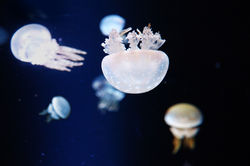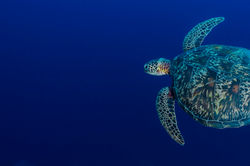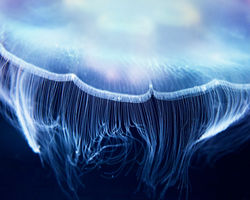ISSSB-International Summer School on Systems Biology
The Systems Biology approach to discover marine life:
from a big eye to a microscopic picture
10-14 October 2022
Biological systems are complex networks of biological entities such as organs, tissues, cells, organelles, macromolecular complexes, regulatory pathways and at macro scale individuals.
Oceans represent a perfect example of a biological system made of a huge numeber of interconnected biodiverse systems both as species and as niches. Understanding how their connections results in its health and equilibrium require a wide approach looking at it from all the possible angles.
Systems biology aims to provide a comprehensive view of the biological systems using an interdisciplinary integrated approaches from different scientific areas and technological, experimental and informatic skills.
Based on this holistic view, the aim of the school is to provide participants basic and advanced knowledge on Biodiversity, Ecological interactions, Evolutionary Genomics and Omic disciplines, to be used as an integrated approach applied to oceans for EcoEvoDevo studies and Biotech Applications.
 |  |  |
|---|---|---|
 |  |  |
 |  |  |
 |  |  |
 |  |  |
 |  |
Teachers
Top international Professors and Researcher
The teachers of the ISSSB-International Summer School on Systems Biology are very expert and top level researcher and professor from a wide variety of disciplines and backgrounds. What unites them is a continuous passion for learning and discovery. Find out who they are.

Prof. Ferdinando Boero
Professor, University of Naples "Federico II"- Chair of the Stazione Zoologica Anton Dohrn-President of the Dohrn Foundation
Ferdinando Boero, Professor of Zoology. Chair of the Stazione Zoologica Anton Dohrn. Associated with CNR-IAS. President of the Dohrn Foundation. Member of the European Marine Board. Vice-president of the Marevivo environmental association, member of the Scientific Council of WWF Italy, and Pro Natura. He has coordinated numerous national and international research projects, has published hundreds of articles, book chapters and books on: Marine Biodiversity and Ecosystem Functioning, Marine Protected Areas, Evolution, Scientific communication, Sustainability. He has conceived the exhibit of the Darwin Dohrn Museum of the Zoological Station Anton Dohrn. Main honors: Grand Medaille Albert 1er pour l'Océanographie of the Institute Océanographique de Paris. Medal of the National Academy of Sciences for the Class of Physical and Natural Sciences Golden Trident.

Prof. Lucie Bittner
Associate Professor, Sorbonne Université and Muséum National d'Histoire Naturelle, Paris , France
Lucie Bittner is an ecologist and evolutionist, who have always been fascinated by the diversity of living forms, notably in the ocean.
During her PhD, she studied molecular phylogeny and environmental diversity of macro-algae. During her post-docs, she moved to microbial ecology and studied taxonomical and functional environmental diversity using (meta)omics. As an Associate Professor since now 9 years, she daily use bioinformatics, statistics, numerical ecology, and collaborate with modelers to integrate meta-omics and oceanographic knowledge at the global ecosystem level.

Dr. Maurizio Ribera D'Alcalà
Alumni associated to Stazione Zoologica Anton Dohrn, Integrative Marine Ecology Department
Maurizio Ribera D'Alcalà Trained as physical-chemist could profit of a fellowship at SZN to 'discover' a new world. This was not too much enjoying the beauty of benthic biocenoses, the most accessible to direct view, but it was the challenge of understanding the dynamic of pelagic microbiota in the context of a fluid envirnoment. Most of his scientific career developed in the SZN environment, a very stimulating one for what concerns the analysis of the interplay among biotic and abiotic factors in driving the functioning of pelagic ecosystems and the evolutionary pathways. He worked on Mediterranean biogeochemistry and, more recently, on plankton dynamics and biology. He tried to convey what he learned to students either by teaching biological oceanography and by tutoring master and PhD students. Still now, his main interest is understanding the crucial role that biota play in shaping Earth system dynamics, in a Gaia-like view, being aware of the need to rely on complex system theories to advance in that understanding.

Dr. Domenico D'Alelio
Researcher, Stazione Zoologica Anton Dohrn Napoli, Integrative Marine Ecology Department
Domenico D'Alelio main interest is ecology and evolution of marine plankton. His scientific production is multidisciplinary and goes from the biology and evolution of aquatic microorganisms to community ecology, with a specific focus on food webs and dynamics of socio-ecological systems. He is involved in several research projects, both basic ones, pertaining to the exploration of the biological complexity of living beings, and applied ones, pertaining to the management of marine resources. Attracted by the interaction between nature and society, he disseminate science by means of science writing and music.
Dr. Daniele Iudicone
Senior Researcher, Stazione Zoologica Anton Dohrn Napoli, Integrative Marine Ecology Department
Daniele Iudicone The oceans are the largest ecosystems on the planet and play a crucial role in many aspects of living on it. The peculiar physical context in which marine organisms live sets constraints and provides opportunities for specific adaptations, thus impacting organisms’ ecology and evolution.
The definition and understanding of the physical processes that are relevant for the marine biota are thus at the core of his research as oceanographers. He investigate the nature and impact of small scale mixing on plankton and the specific adaptive responses. Within the context of the climate change he also investigate the large scale circulation and dynamics and its impact on the exchanges of biogeochemical tracers between the surface and the deep layers and on the dispersal of organisms. A preferred conceptual framework for these analyses is the watermass framework developed by Walin that he contributed to expand.
He combine experimental, numerical and theoretical tools using a fully multidisciplinary approach. This implies collaborating with molecular biology, bioinformatics and ecology teams. The research is supported by national and international programmes. Presently a large part of the research is made in the collaborative framework of the Tara Oceans project (http://www.embl.de/tara-oceans/start/).

Dr. Juan Pascual-Anaya
Senior Researcher,
Department of Animal Biology, Faculty of Science, Malaga University
Malaga, Spain
Juan Pascual-Anaya from University of Malaga (Spain) is an evolutionary developmental biologist working on vertebrates’ morphological diversity and evolution. During his research career he has provided novel answers to Evo-devo (Evolutionary Development) questions using genomics and transcriptomics. Evo-devo (Evolutionary Development) represent the crossroad between the classical developmental biology and evolutionary biology. Evo-devo tries to explain how changes in the developmental programs of living organisms lead to the appearance of morphological and physiological novelties. He is particularly interested in vertebrate novelties and innovations.

Dr. Maria Ina Arnone
Research Director, Biology and Evolution of Marine Organisms Department, Stazione Zoologica Anton Dohrn Napoli
Maria Ina Arnone, biochemist by training, is a developmental molecular biologist with expertise in gene expression analysis, functional genomics and gene regulatory network (GRN) studies. After a period of three years (1995-1998) at the California Institute of Technology, Pasadena, CA, where she contributed to a seminal work on the organization and function of genomic regulatory systems (reviewed in Arnone and Davidson, Development 1998, 836 citations), she established her group at Stazione Zoologica in Naples with the aim of studying evolution of organs and body parts by comparison of the GRNs that control the formation of such parts in different animals. Using the sea urchin embryo as main model system, she recently developed a novel approach integrating various 'omics' technologies to study developmental GRNs and their evolution.

Prof. Lugi Cerulo
Associate Professor in Computer Science at Univeristy of Sannio, Department of Science and Technology
Luigi Cerulo is an associate professor of Computer Science at University of Sannio were he is leading the bioinformatics lab of Department of Science and Technology. He is also an associate researcher of the bioinformatics research group at the Biogem Molecular Biology and Genetics Research Institute.
After completing a doctoral thesis in software engineering at University of Sannio, Luigi became involved in computational biology in 2008 in the research group of prof. Michele Ceccarelli. He become active in the field of reconstructing gene regulatory networks from trascriptomics and genomics data contributing to decipher functional alterations in cancer. He collaborates with molecular oncology research gropus of Columbia University (NY), Qatar Computing Research Institute, University of Verona, and University of Naples "Federico II". Currently, with his research collaborators, he is leveraging the most recent advances in graph neural networks to reflect the rich structure of biological phenomena and learn representations from non-coding sequences.
He published more than 70 paper, some awarded in international conferences, and serve as associate editor in the medical bioinformatics section of the Springer Nature Journal of Translational Medicine.

Dr. Luca Ambrosino
Technician, Research Infrastructures for MArine biological Resources (RIMAR) Department – BAC unit, Stazione Zoologica Anton Dohrn Napoli
Luca Ambrosino is a molecular biotechnologist with a PhD in Computational Biology and Bioinformatics gained at the University of Naples "Federico II". I worked at CEINGE - Biotecnologie Avanzate S.c.a.r.l. on structural characterization of disease-causing mutant enzymes; at the Institute of Protein Biochemistry (IBP) of CNR on the structural and functional characterization of extremophile enzymes with a biotechnological potential; at the Agricultural Department of the University of Naples "Federico II" on comparative genomics and molecular evolution of plant species of agronomic interest. Now, I am member of the Bioinformatics, Computational Analysis & Data Management (BAC) unit of Stazione Zoologica Anton Dohrn. My current activities focus on structural and functional genomics, comparative genomics and molecular evolution of marine species

Prof. Tilmann Weber
Professor for Natural Products Genome Mining, Novo Nordisk Foundation Center for Biosustainability, Technical University of Denmark.
Tilmann Weber is Professor for Natural Products Genome Mining and Associate Scientific Director of the “Natural Products Genome Mining Group” at the Novo Nordisk Foundation Center for Biosustainability of the Technical University of Denmark.
His main research interest is focused on deciphering the molecular pathways and engineering the biosynthesis of natural products by combining genetic, biochemical and bioinformatics methods. He is a pioneer in developing software for the automated genome mining (CLUSEAN, antiSMASH, antiSMASH-DB) and analysis of secondary metabolite biosynthetic pathways. His group was able to firstly elucidate the biosynthetic pathways of the elfamycin family of antibiotics and is deeply involved in developing CRISPR-based metabolic engineering tools for actinomycetes.
Tilmann Weber is faculty of the DNRF-funded center of excellence “Center for Microbial Secondary Metabolites” (CeMiSt; www.cemist.dtu.dk) at DTU, and coordinator of the NNF Challenge grant “Integration of Informatics and Metabolic Engineering for the discovery of novel antibiotics” (iimena; www.iimena.org ) and the HE-MSCA doctoral Network MAGiC-MOLFUN, which will start in 2023.
He is member of the Editorial Board of “Metabolic Engineering”, and Associate Editor of “Synthetic and Systems Biotechnology”.
